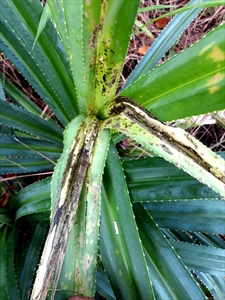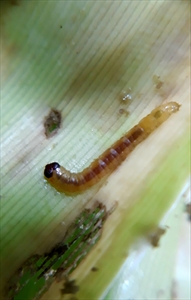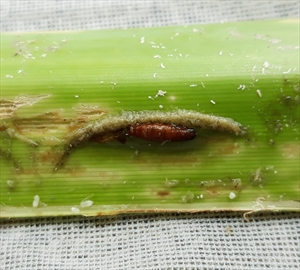Pandanus leaf webworm
Pacific Pests, Pathogens and Weeds - Online edition
Pacific Pests, Pathogens & Weeds
Pandanus leaf webworm (389)
Aeolarchis sphenotoma. It was known previously as Erechthias fibrivora, and before that Decadarchis fibrivora, the name under which it was described. It is a moth of the Tineidae, fungus moths.
Not known precisely. It has been recorded from Fiji where it is endemic. There is scant literature on this moth. Swaine (1970)1 says that he did not find it in American Samoa or (Western) Samoa.
Pandanus caricosus and Pandanus thurstoni. The local name is voivoi or kieke.
The larvae or caterpillars do the damage. The larvae web the young leaves together at the tips and feed inside on the outer layers (Photo 1). As the leaves mature, the affected areas become silvery and withered.
The mature larva is about 16 mm long, with a flattened yellow body and red-brown head (Photo 2). The pupa is 9 mm long, red-brown and slightly flattened inside a tough, parchment-like oval cocoon, which is bordered by a crescent-shaped mass of chewed plant tissue and attached to the inside of the webbed leaf (Photo 3).
The adult is 9 mm long and light-brown (Photo 4). The forewings are golden-brown with a V-shaped cream patch; the hindwings are dull-brown, pointed and lightly fringed with thick hairs.
A serious pest which can cause extensive damage to the leaves. Pandanus caricosis and Pandanus thurstoni are important species in Fiji used for making mats, baskets, fans and other handicrafts. Of the two, Pandanus caricocis is considered the best. It is also said to be used to treat diarrhoea.
Look for the damaged leaves, and the larvae with yellow body and red-brown head.
CULTURAL
During growth:
- Cut off the tips of the leaves that are webbed together and destroy them.
CHEMICAL CONTROL
- Use any of the following (PDPs, botanicals) insecticides against lepidoptera larvae: chilli, pyrethrum or derris if natural supplies are available (see Fact Sheet no. 56).
- Use a commercial microbial insecticide against lepidoptera larvae: Bt (Bacillus thuringiensis), spinosad or the chemically related spinetorum (Success).
- Use synthetic pyrethroids. However, these products are likely to kill any parasitoids if they are present and should be avoided, if possible.
- Spot-spraying damaged shoots should be sufficient. Avoid 'blanket' spraying entire trees.
____________________
When using a pesticide, always wear protective clothing and follow the instructions on the product label, such as dosage, timing of application, and pre-harvest interval. Recommendations will vary with the crop and system of cultivation. Expert advice on the most appropriate pesticide to use should always be sought from local agricultural authorities.
AUTHOR Grahame Jackson & Mani Mua
1Information from Swaine G (1971) Agricultural Zoology in Fiji. Her Majesty's Stationery Office. London.
Produced with support from the Australian Centre for International Agricultural Research under project HORT/2016/18: Responding to emerging pest and disease threats to horticulture in the Pacific islands, implemented by the University of Queensland and the Pacific Community.







